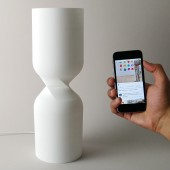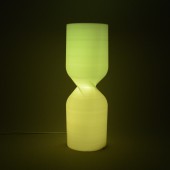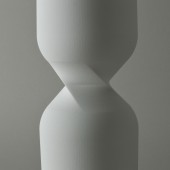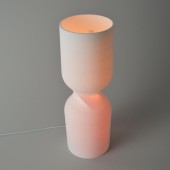
| THE AWARD |
| CATEGORIES |
| REGISTRATION |
| SUBMIT YOUR WORK |
| ENTRY INSTRUCTIONS |
| TERMS & CONDITIONS |
| PUBLICATIONS |
| DATES & FEES |
| METHODOLOGY |
| CONTACT |
| WINNERS |
| PRESS ROOM |
| GET INVOLVED |
| DESIGN PRIZE |
| DESIGN STORE |
| THE AWARD | JURY | CATEGORIES | REGISTRATION | PRESS | WINNERS | PUBLICATIONS | ENTRY INSTRUCTIONS |
Enlighten Phone Use Tracking Lamp by Shreyans Bhandari |
Home > Winners > Design #80933 >Interview |
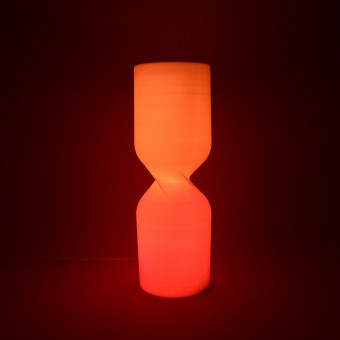 |
|
FS: What are your future plans for this award winning design?
SB: Present this idea to companies leading in technology, design, or home furnishing. Especially since we move into the area of health, wellness and mindfulness, this concept would add a lot of value to people's digital life.
FS: How long did it take you to design this particular concept?
SB: 3 months
FS: Why did you design this particular concept? Was this design commissioned or did you decide to pursuit an inspiration?
SB: As an interaction designer, I was interested in questioning if my interface designs were good for people's lifestyle, health and relationships. I designed this particular concept to make people more aware of their digital life, and not completely detach themselves. But to make the best decisions of their use of time and energy.
FS: What made you design this particular type of work?
SB: My interests in health, wellness, and inner peace, combined with my design instincts and engineering background to prototype and make it all work, and most importantly to tell a compelling story about the problem and how I intend to approach it.
FS: Where there any other designs and/or designers that helped the influence the design of your work?
SB: Industrial design faculty of the Rhode Island School of Design RISD. Fellow graduate students
FS: Who is the target customer for his design?
SB: Smart-phone users
FS: What sets this design apart from other similar or resembling concepts?
SB: Awareness, playfulness, agency and control of product use
FS: How did you come up with the name for this design? What does it mean?
SB: enLighten means a lot of things. Thats why I chose it. It includes "light" which attributes to a source like a lamp. Enlighten, in the spiritual context, means to reach a higher level of consciousness and wisdom. In this case, using light to tell us something that has a lot of meaning associated with the passage of time, our interactions with phones and its impact on our lifestyle, health and relationships.
FS: Which design tools did you use when you were working on this project?
SB: CAD software, extrusion 3D printing, SLS 3d printing, arduino, electronics
FS: What is the most unique aspect of your design?
SB: Its dynamic quality due to its relationship with our phone interactions is the most unique aspect. The fold in the center turns a seemingly simple cylinder into an abstraction of an hourglass. But the scale is absurdly unique and whimsical.
FS: Who did you collaborate with for this design? Did you work with people with technical / specialized skills?
SB: Individual work and learning
FS: What is the role of technology in this particular design?
SB: Technology plays a huge role in this design. The relationship between the phone and another object is made possible only by technological tools including electronics and logic. When thinking about the form, it is wholly produced by a single SLS laser printer which is a cutting edge new technology in the manufacturing world. So this entire concept, function and form is supported by technology.
FS: Is your design influenced by data or analytical research in any way? What kind of research did you conduct for making this design?
SB: A big part of my creative process stems from user research methodologies that include user conversations, prototyping and testing. By asking people to map their phone use throughout the day I learned that phone-use during bedtime was the most common and indulgent. Moreover, content rich apps that are immersive and persuasive as used during this time. All these insights were instrumental in designing this product and its context of usage.
FS: What are some of the challenges you faced during the design/realization of your concept?
SB: Realization of the 3d print design in the actual scale (1 feet tall single SLS print) with complex lofting in the center. I was afraid the plastic would be weak at those folds. So I had to do a lot of prototyping and testing to land on the right about of fold. The technical development of phone and lamp communication was tricky, and required a lot of logic based decisions much like a software engineer. But as a designer always trying to view it from a user centered perspective.
FS: How did you decide to submit your design to an international design competition?
SB: People loved its visually provoking form, the concept, and how it worked. The 3D print worked out wonderfully. All these aspects of the project compelled me to submit my design.
FS: What did you learn or how did you improve yourself during the designing of this work?
SB: I think I grew immensely as a designer, considering user interaction, integration in their lives, form evolution, technological incorporation. All these aspects have greatly added to by design practice.
FS: Thank you for providing us with this opportunity to interview you.
A' Design Award and Competitions grants rights to press members and bloggers to use parts of this interview. This interview is provided as it is; DesignPRWire and A' Design Award and Competitions cannot be held responsible for the answers given by participating designers.
| SOCIAL |
| + Add to Likes / Favorites | Send to My Email | Comment | View Press-Release |
